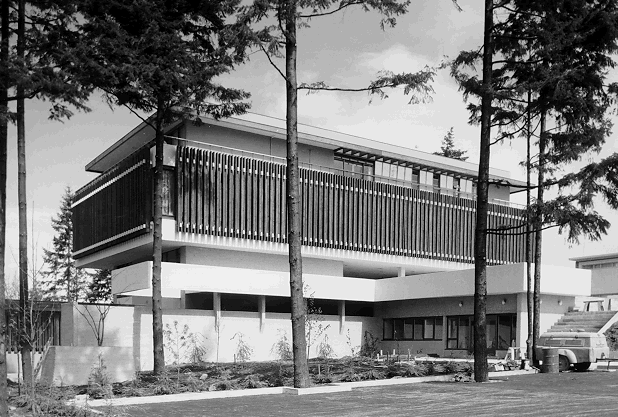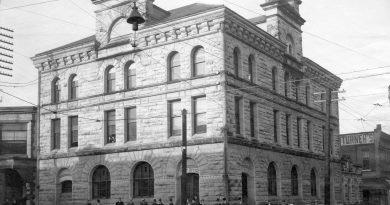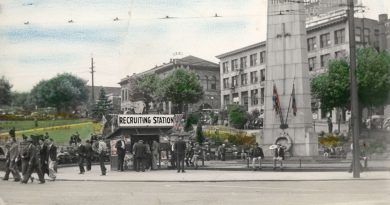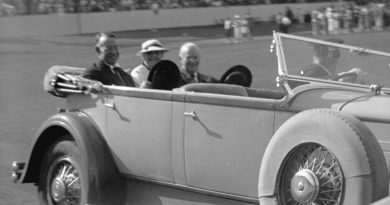1959
Above: Thea Koerner House (Graduate Student Centre).
[Image: UBC Archives Photo #1.1/1564]
*****************************************
You’ll note that these years include events listed under “Also in . . .” These are events for which we don’t have a specific date. If YOU know the specific date of an event shown there, please notify us . . . and cite the source! Many thanks!
*****************************************
January 3 Alaska became a state.
January A four-day Chinese New Year celebration was held in Vancouver’s Chinatown for the first time, sponsored by Chinese-Canadian businessmen.
February 5 Jennifer Granholm was born in Vancouver. Today, she’s the Governor of Michigan.
March 16 The first ship, the Lake Atlin, docked at Vancouver’s brand new Centennial Pier, operated by the National Harbours Board.
March Munich, Germany-born (May 11, 1908) Erwin Swangard, who had come to Canada in 1930 and worked for both the Province and the Vancouver Sun, was appointed managing editor of the Sun.
May 4 Canadian Pacific Airlines started a Trans-Canada service, Montreal to Vancouver.
May 5 Lynn Seymour (born Lynn Springbett March 8, 1939 in Wainwright, Alberta), who began her training in Vancouver, became a principal dancer in the Royal Ballet this year, and danced the lead today in that company’s Swan Lake. Her astonishing career is nicely described at this website. A quote from that site: “A later performance in Swan Lake at Covent Garden won critical acclaim in London. Vancouver papers were so lyrical it embarrassed her. Later that year, she made her debut at the Metropolitan Opera House in New York, where Martha Graham, the great dancer and choreographer, turned to Dame Ninette [de Valois] and exclaimed, ‘It’s not fair: she’s got it all!’”
May 6 Vancouver’s Oakridge shopping centre opened at Cambie Street and West 41st Avenue, the first shopping centre in the city. West Van’s Park Royal had opened in 1950.
May 15 Vancouver’s Harry Jerome broke the world record for the 220-yard dash. The record had been set 31 years earlier by Percy Williams, also of Vancouver.
May 23 The Deas Island Tunnel opened for traffic. Tolls would be collected until 1964. See July 15 below for more details.
Ladner’s Landing was turned, thanks to the tunnel, from a rural enclave into a busy townlet.
One unforeseen result of the tunnel opening: there was a sudden upsurge in visits by Canadians to Point Roberts, the tiny chunk of Washington State that, thanks to the 49th parallel, is accessible by land only through Canada. And why were they coming in their thousands? Sunday drinking. “Boozing Canadians leave Point Roberts a Hangover,” one headline read. A popular bumper sticker read “Sunday Services at the Breakers.” (The Breakers was a Point Roberts drinking hole.)
June 11 The Vancouver Maritime Museum opens. Good detail.
June 26 Queen Elizabeth II and US President Dwight Eisenhower opened the St. Lawrence Seaway.
June UBC opened a Faculty Club and Social Centre. It was the second club, the first being a very modest affair, a converted three-section army hut once used as an officers’ mess at the New Westminster barracks. Work to prepare the site at the north end of Main Mall began in 1946 and that first club opened for a housewarming on January 5th, 1947.
The 1959 club was a decided advance! It was a gift from Mrs. Thea and Dr. Leon J. Koerner. The architect was Fred Lasserre, a UBC professor of architecture. As the campus residence for visiting royalty, the club was honored by the presence of both Queen Elizabeth and Prince Charles. The Faculty Club, built at a cost of $750,000, had both public and private dining rooms, a reading room, lounges, a music room, a snack bar, a games room and four salons. It was the centre of social activity for UBC Faculty.
Faced with financial insolvency the club closed its doors in 1994. However, in March, 1999 it sprang back into life as the Leon and Thea Koerner University Centre, “ensuring that the facility will continue to fulfill the original vision of its donors.” Visit this website.
July 3 McCleery Public Golf Course opened.
July 5 The Queen Elizabeth Theatre opened.
July 15 When you drive through the George Massey Tunnel under the Fraser River, near the airport, you’re driving through the lowest point on a public road in Canada. The roadbed is 20 metres below sea level. The tunnel (open to traffic since April, 1958) was officially opened today by Queen Elizabeth and Premier W.A.C. Bennett. Her Majesty presided over the official opening of the already-operational Deas Island Tunnel (now the George Massey Tunnel), and took part with Premier Bennett in an ancient and curious ceremony: The premier handed the Queen a costly pair of silver scissors, and she gave him a dime for them. The coin-for-scissors trade is an old British custom, which holds that if the giver of a cutting implement does not receive a coin in return, the friendship between the giver and the receiver will be cut. The Queen and Prince Philip were busy during their brief visit here. Her Majesty also “graciously assented” to having the Queen Elizabeth Theatre named for her, then popped over to Victoria for a civic luncheon. There the royal couple met Archbishop William Mark Duke, and Prince Philip was photographed shaking hands with him . . . inspiring the caption “Duke meets Duke.”
Later that evening, Her Majesty had dinner at UBC’s new Faculty Club.
Also July 15 The Delta Princess makes her last 10-minute run from Woodward’s Landing in Richmond to Ladner. The construction of the Deas Island Tunnel has made the service redundant.
July Westwood Motorsport Park opened in Coquitlam, at the time the only European-style race track in Canada. For 31 years the track would host local, national and international motor racers. It would close in 1990 when the land was sold by the provincial government for residential development.
September 14 A Russian rocket hit the moon, the first time a man-made object had touched an extra-terrestrial body.
September 24 New Westminster Mayor Beth Wood was presented with a gold key to the city of Long Beach, California to commemorate a softball contest between the two cities. “A great many people,” Mayor Wood later told a laughing New Westminster council, “didn’t seem to know where New Westminster is, but they placed it soon enough after I told them that Vancouver was one of our suburbs.”
October 9 Movie actor Errol Flynn arrived in Vancouver with his teenage companion Beverly Aadland. Jobs for Flynn were now few and far between and he was, understandably, continually plagued with money problems. He came to Vancouver as a result of a call he had received earlier from an old friend, stock promoter George Caldough. It happens that at the time Flynn called Caldough was in a financial bind himself. As he later wrote in Weekend Magazine—a long, cheerful piece he wrote in prison—Caldough was desperate “for some new vision to bail me out and put my company on an equitable footing—but what?”
Flynn’s call gave him the answer. The actor wanted to know if Caldough was still interested in buying his yacht, the Zaca. (Caldough had admired the boat extravagantly.) He was, and arranged to meet Flynn in Hollywood the following week. Caldough had recently read about an American company that intended, through public subscription of $1.9 million, to finance a deep-sea treasure-hunting expedition off the coast of Spain. Caldough, his brand churning, began thinking about the Zaca, with ERROL FLYNN at the helm, searching for sunken Spanish gold. That would raise one hell of a public subscription.
In a fever of excitement and speculation Caldough flew to Hollywood and met Flynn.
He was shocked by the actor’s appearance. “We hadn’t met in two years, but he had aged 20 . . . He followed me to Vancouver — accompanied by his 17-year-old friend, Beverly Aadland — after about 10 days. If anything, his appearance had deteriorated and he seemed to need help in just getting around. But his personal charm was unabated . . .”
Flynn and Aadland stayed with the Caldough family on Eyremount in British Properties for several days during that October 1959 visit. “He seemed to be happiest when reminiscing, watching TV or talking to my children,” Caldough wrote. Even though his glory days were done, Flynn’s visit excited Vancouver mightily. He was delighted when Orpheum Theatre manager Ivan Ackery went to great lengths to obtain and show a short film Flynn had made about the Zaca in 1952, and phoned Ackery to thank him.
Flynn was supposed to go to New York for a TV show, but his famed disregard for time was in full flower. The Caldoughs half-heartedly tried for three days to get him on the flight to New York, but they kept missing it. There was always another party, more people to entertain, more Hollywood stories to tell.
Finally—it was October 14, 1959—Flynn said he really did have to go and suggested they leave for the airport three hours early.
En route, Flynn began to experience severe pain in his back and legs. Caldough, who was driving, veered off and headed for the West End apartment—at 210-1310 Burnaby Street—of a friend, Dr. Grant Gould. Astonishingly, not long after their arrival, a few people materialized and another party began!
Flynn, who was standing against a wall to relieve the pain in his back, regaled the group with stories of the Hollywood figures he had known, especially John Barrymore and W.C. Fields (both, tellingly, heavy drinkers). He was, apparently, a superb story teller. But then he stopped and announced he was going to lie down for an hour and then would take everyone out for dinner. He moved into the doctor’s bedroom and lay down on the floor.
When Beverly Aadland looked in on him a little later to see how he was, she found him trembling, his face blue. She could hardly hear his heart. Her screams brought the doctor . . . but it was already too late.
Al Gowan, a member of the inhalator squad (summoned by one of the guests, Art Cameron, manager of the Sylvia Hotel at the time), said “Flynn was dead before we got there. The man was a living skeleton. His liver was gone, his heart was gone.”
The death certificate, dated October 23, indicated myocardial infarction, coronary thrombosis, coronary atherosclerosis, liver degeneration, liver sclerosis and diverticulosis of the colon as the causes of death.
Flynn’s autobiography came out that same year. It was titled My Wicked, Wicked Ways. They caught up with him in Vancouver. He was 50.
See Backstage Vancouver page 106ff.
October 11 William Harold Malkin, who was mayor of Vancouver in 1929 and 1930, died, aged 91. He was born July 30, 1868 in Burslem, Staffordshire, England. “Sandwiched between L.D. Taylor’s double terms of office,” Donna Jean McKinnon writes, “merchant and importer William Malkin benefited from public disillusionment with Taylor. He gained the distinction of being the first mayor of Greater Vancouver following amalgamation with Point Grey and South Vancouver in 1929. One of Malkin’s campaign slogans during the electoral race in 1928 was “It’s time for a change.” Another was “When you vote for Malkin, you vote for law and order, civic morality and fairness to labor.” Malkin established a committee to look into corruption and embezzlement in the city’s Relief Department and worked to bring about changes in civic policy to benefit the working class. He later donated a 2.4 hectare park behind his Kerrisdale home to the city as well as the money for construction of Malkin Bowl in Stanley Park, the latter dedicated to his late wife Marion.
November 5 Singing superstar Bryan Adams was born in Kingston, Ontario. He came to North Vancouver in the early 1970s. Says Rolling Stone: “Perhaps no other modern musician is as synonymous with mainstream pop rock music as Bryan Adams. Since embarking on a solo career in 1980, Adams has sold more than 45 million albums worldwide.”
November 16 The Sound of Music premiered on Broadway.
November 18 It was announced by Dr. Norman McKenzie, the president of UBC, that Leon Koerner, the retired chairman of Alaska Pine and Cellulose Ltd., had given the university $400,000 to pay for the construction of a graduate students’ centre. The building was to be called Thea Koerner House in memory of Mr. Koerner’s wife, who had died in July.
The building would go up on the West Mall, just west of the faculty club . . . which also was built with a Koerner donation (of $600,000). The students’ centre, “would be a meeting place for students in different fields to exchange ideas and opinions.” It won the Massey Gold Medal for Architecture in 1961 as an outstanding piece of Canadian architecture.” Architects were C.E. Pratt and P. Kattfa of Thompson, Berwick & Pratt.
Dr. Koerner lived in the penthouse of the building during the summer months from the time the building was completed in 1961 until his death in 1972. The building—which today includes a 1971 extension paid for by graduates—serves as a social and cultural centre for students in graduate studies. The centre is very active during the school year, with events sponsored by the Graduate Student Society. Transcendence, the fountain sculpture in front of the building, was sculpted by Jack Harmon.
November 26 With CBC Television soon to go on air in Vancouver, the Province ran a multi-page feature on the relatively new medium. One article, for example, told how to read a test pattern. “When the larger circle fills the screen and still remains perfectly circular, the largest possible picture is obtained and you still retain the proper aspect ratio (correct height as related to width). If by chance the circles are ovalled, picture distortion is occurring . . .” and so on and so on for three columns.
December 7 CHQM AM 1320 signed on at 6 a.m. with an easy listening format. See this site.
Also in 1959
Tom Alsbury became mayor of Vancouver. The first of our mayors born in the 20th century (1904 in Edinburgh, Scotland), Alsbury, writes Donna Jean McKinnon “gained notoriety with his policy of closing Board of Administration meetings to the public, saying he had ‘no intention of taking a second look at the policy.’ Despite his progressive goals and humanitarian interests, (he’d worked for the CCF for 24 years before resigning upon election), his abrasive, hard-nosed personal style alienated many would-be supporters and eventually led the Non-Partisan Association (NPA) to reject his candidacy for the mayoralty term of 1963-64. He later became a lively radio commentator on civic and provincial affairs, and became involved in improving the lot of senior citizens.”
Major league baseball player Brooks Robinson, born in Little Rock in 1937, was sent down to the Triple A Vancouver Mounties by the Baltimore Orioles. “They sent me to Vancouver in the Pacific Coast League,” Robinson later recalled. “I was shocked. That was the only time I was ever frustrated in baseball. My ego was really hurt. I thought of all my friends back in Arkansas talking about me being sent down. Yet it turned out to be the best thing that could have happened to me. I did very well at Vancouver and was brought back at the All Star break. And it was like night and day. I could hit! I had more confidence and I had gotten stronger physically, so I was no longer overmatched.” Called the “ultimate third baseman,” and the “human vacuum cleaner,” Robinson was elected to baseball’s Hall of Fame in Cooperstown, NY in 1983, the only member of the Hall to play for a Vancouver team.
Dr Harold Rice at St Paul’s Hospital built Canada’s first heart-lung machine.
The Barbie Doll was introduced. See this site.
The Powell River Co., a major forest products firm, amalgamated with MacMillan Bloedel.
St. Paul’s Boarding School on the Mission Reserve in North Vancouver, consecrated January 22, 1899 by Bishop Durieu, was demolished.
A residence for native girls, Durieu Convent, was built next to St. Paul’s Indian Catholic Church in North Vancouver. It would be demolished in October 1982.
More than 1,000 people attended the funeral of Andy Paul, Squamish native leader, at St. Paul’s Indian Catholic Church on North Vancouver’s Mission Reserve. He had been honored by Pope Pius XII in 1955 for his contribution to the Church and to the native people of Canada. Paul was active for many years in the native land claims question and was the founder of the North American Indian Brotherhood.
Surrey Memorial Hospital opened.
Rezoning of 20 hectares in West Vancouver permitted 78 high-density apartments in Ambleside.
Tolls came off the Oak Street Bridge, opened July 1, 1957.
The death penalty was abolished in Canada.
The Polish Community Centre opened on Fraser Street.
The largest Catholic church in Vancouver, Our Lady of Sorrows, was built at 555 South Slocan Street. The crest of the Servite Fathers was set in the floor of the sanctuary to honor the parish’s founding fathers. See this site.
A south wing was added to the Biological Sciences Building (Botany, Zoology, Oceanography and Microbiology) at UBC.
The Centennial Pavilion, a cruciform-shaped, 12-storey building opened at Vancouver General Hospital.
The Centennial Wing at Burnaby Hospital opened, bringing the hospital’s total to 250 beds, 63 bassinets.
The British Columbia Women’s Hospital and Health Centre, at 4490 Oak Street in Vancouver, had a new 99-bed wing officially opened by Lt.-Gov. Frank Ross.
The British Columbia Medical Journal, a monthly publication from the British Columbia Medical Association, began.
Canadian Literature/Litterature Canadienne: a quarterly of criticism and review, with text in English and French, began to be published by the University of British Columbia. It is “devoted to the study of all aspects of Canadian writing.”
Winnipeg-born writer (May 8, 1912) George Woodcock, who had moved to B.C. in 1949, accepted the part-time position of founding editor of Canadian Literature, the first periodical to be entirely devoted to Canadian writing. “He did not,” writes Alan Twigg, “instigate the publication that he edited until 1977, as is sometimes assumed.” See a long and admiring article on Woodcock by Twigg at this site.
Geppo, a monthly publication for and about the Japanese-Canadian Community, published by the Japanese Canadian Citizens Association of Greater Vancouver, began.
The PIBC News, published five times a year by the Planning Institute of British Columbia, began. It “presents articles and news of local events of interest to the practicing urban and regional planners of British Columbia.”
Prism International: a Quarterly Journal of Contemporary Writing, published by the Creative Writing Department at UBC, began.
The University of British Columbia Law Review, a semi-annual publication of UBC’s Law Review Society, Faculty of Law, began. It is dedicated to the “promotion of legal scholarship, with articles by judges, professors and practising lawyers.”
The Union Steamship Company, active in BC from the days of the Fraser River gold rush, was absorbed by Northland Navigation Co.
The Lady Alexandra, built in 1924, became a floating restaurant in Coal Harbour. Later (1972) she would be towed to Redonda Beach, California, to become a gambling hall. Storm-damaged in 1980, she was scrapped.
VanCity credit union offered Canada’s first open mortgage (a mortgage that can be prepaid or re-negotiated at any time without additional interest.)
Annacis Island-based Industrial Engines Limited was incorporated “with the express purpose of marketing industrial engine power products in the power generation, industrial and marine fields in Western Canada.”
Stan Leonard, once the pro at the Marine Drive Golf Club, was named World Golfer of the Year by the Golf Writers’ Association in the U.S., the only Canadian to be so honored.
William Dale, director of the Vancouver Art Gallery, announced that there were only two or three works of art worth the name in the gallery’s permanent collection. William Jarvis, a former National Gallery director, called the VAG’s permanent collection, excepting Emily Carr, “pitiful.”
Sculptured murals, by Gordon Smith, were installed at the Queen Elizabeth Theatre. Writes journalist Elizabeth Godley, “Smith, one of the Vancouver art community’s ‘grand old men,’ had to learn to weld to produce this metal and enamel piece.”
Cycle of Flowering, a mural by Jack Shadbolt, was installed in the Queen Elizabeth Theatre Restaurant. It was four feet high, 50 feet long. (1.2 metres by 15.2).
Author Guy Bennett was born in Cambridge, England. He came to Vancouver in 1968. See this site.
Writer Audrey Thomas, born November 17, 1935 in Binghamton, New York, came to Vancouver. (She lives on Galiano now.) Thomas has written much, and would be the first winner of the Ethel Wilson B.C. Fiction Prize for her 1984 novel Intertidal Life. She has won many more awards. There is a long and interesting entry on her (including a fine interview by Alan Twigg) at this site.
The Vancouver Folk Song Circle was started by Phil Thomas, B.C.’s leading folk music historian, and his wife Hilda. His books include Songs of the Pacific Northwest and Twenty-five Songs for Vancouver 1886-1986. See this site.
Chief Dan George (birth name: Teswahno) began his acting career at age 60. He would appear in the first production of The Ecstasy of Rita Joe by George Ryga (1967). His funny and dignified performance in the 1970 film Little Big Man earned him an Oscar nomination.
Toronto-born Hugh Keenleyside, who had worked for the UN in the 1950s, was named Chair of the BC Power Commission. He would hold that post to 1961.
Arthur Laing, who had been elected as the first Liberal MP for Vancouver South (in June 1949), then resigned from federal office in 1953 to become B.C. Liberal leader, retired. It didn’t take. He would get back in the game in 1962 and become a federal cabinet minister (Indian Affairs) under Prime Minister Lester Pearson. Later, he became Public Works minister under Pearson’s successor, Pierre Trudeau. The Arthur Laing Bridge was named for him on his 70th birthday, September 9, 1974. He died in Vancouver February 13, 1975.
Mildred Valley Thornton, artist and art critic, stepped down after 16 years as art critic for the Vancouver Sun.




